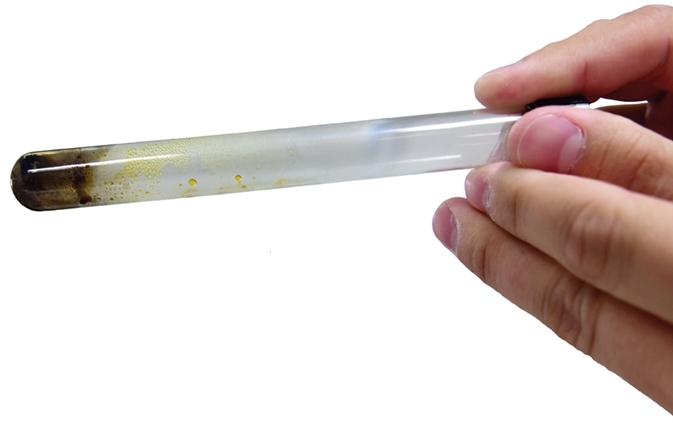

Researchers show that the sweetener sucralose tends to degrade at 98°C, releasing organochlorine compounds with potentially irritant and carcinogenic effects (photo: Jornal da Unicamp)
Researchers show that the sweetener sucralose tends to degrade at 98°C, releasing organochlorine compounds with potentially irritant and carcinogenic effects.
Researchers show that the sweetener sucralose tends to degrade at 98°C, releasing organochlorine compounds with potentially irritant and carcinogenic effects.

Researchers show that the sweetener sucralose tends to degrade at 98°C, releasing organochlorine compounds with potentially irritant and carcinogenic effects (photo: Jornal da Unicamp)
By Karina Toledo | Agência FAPESP – A study conducted at the University of Campinas (UNICAMP) in São Paulo, Brazil, shows that sucralose, the most widely used artificial sweetener in the world and until recently deemed the safest by public health agencies, can become unstable and release potentially toxic compounds when heated to 98°C.
The results of the study, which was supported by FAPESP, have now been published in Scientific Reports, an online journal that belongs to the Nature Publishing Group.
“Previous research had shown that sucralose degrades at high temperatures not typical in daily life, but we found that this also occurs at 98°C, a temperature that can easily be reached when cooking food. This finding was a surprise,” said Rodrigo Ramos Catharino, a professor at UNICAMP’s School of Pharmaceutical Sciences (FCF) and head of the same university’s Innovare Biomarker Laboratory.
Sucralose is created in a laboratory by the chemical modification of sucrose, the scientific name for ordinary table sugar. Three chlorine atoms are added to the molecule’s original structure, making it up to 400 times sweeter. The modification also prevents sucralose from decomposing during digestion and being used by the organism as an energy source.
Its use has been approved without restriction by the world’s major food safety agencies, including the US Food & Drug Administration (FDA) and the Joint FAO/WHO Expert Committee on Food Additives (JECFA), as well as Brazil’s National Health Surveillance Agency (ANVISA).
However, when the researchers at UNICAMP heated sucralose in a water bath for about two minutes they observed that organochlorine compounds were released both in the gas produced by boiling and in the solid phase, i.e., the caramel formed after fusion of the sucralose.
This class of compounds is considered potentially toxic and has a cumulative effect on humans. The techniques used in the analysis included thermogravimetry, mass spectrometry and infrared spectroscopy.
“In the gas, we observed the presence of hydrochloric acid, which can be an irritant if inhaled,” Catharino said. “In the solid phase, we found polychlorinated aromatic hydrocarbons (PCAHs), a recently discovered class of substances about which very little is known.”
According to Catharino, the mutagenic and carcinogenic properties of related compounds such as polycyclic aromatic hydrocarbons (PAHs) are well established in the scientific literature. The main source of exposure to these mutagens is environmental pollution from fossil fuel combustion and cigarettes.
“More research is needed to assess the effects of PCAHs on the human organism, but they’re probably even more reactive than classic PAHs because of the presence of chlorine atoms in the molecules,” he said.
Sweet risk
The analyses that gave rise to the article were performed during Diogo Noin de Oliveira’s Ph.D. research as part of a FAPESP-funded Thematic Project dedicated to investigating mitochondrial dysfunctions and metabolic processes associated with disorders such as diabetes, obesity and dyslipidemia: “Mitochondrial energy metabolism, redox state and functionality in cell death and cardiometabolic and neurodegenerative disorders”.
“We decided to study sweeteners because they’re consumed by so many people with these disorders,” Catharino said. “We began with sucralose, the most widely used of all. Because we intend to use the substance in experiments with animals to test feed formulation, we decided we should first characterize the product and test its stability.”
Heating is one of the main ways to measure a compound’s stability, according to Catharino. The experiment performed by his lab used technical-grade sucralose, the type used by the pharmaceutical and food industries in manufacturing their products.
“It’s slightly different from the sucralose you buy from a supermarket because the consumer version contains additional ingredients to give it body,” he explained. “These ingredients might protect the sucralose from degradation by heating. Or they may boost its toxic effects. We don’t know. We need to find out.”
In the next stage of their research, the group plans to test the effects of the caramel formed by fusing sucralose in cultured human cells and in experiments with mice. The scientists also want to find out whether sucralose breaks down when heated in food to release organochlorines.
Another future step will be an analysis of the stability of other artificial sweeteners and of the byproducts created when they degrade.
In a study published in the journal Food Chemistry in 2012, the group showed that Stevia, a natural sweetener extracted from the plant Stevia rebaudiana, becomes unstable in contact with acidic substances consumed by humans, such as soft drinks and coffee, releasing glucose as well as a steviol, which has potentially carcinogenic and abortifacient activity.
“It’s important to stress that we have no intention of attacking the manufacturers of these products or the food industry,” Catharino said. “We just want consumers to be aware of the potential side-effects when using sweeteners.”
The article “Thermal degradation of sucralose: a combination of analytical methods to determine stability and chlorinated byproducts” (doi:10.1038/srep09598) by Diogo N. de Oliveira, Maico de Menezes and Rodrigo R. Catharino can be read at nature.com/articles/srep09598.
Republish
The Agency FAPESP licenses news via Creative Commons (CC-BY-NC-ND) so that they can be republished free of charge and in a simple way by other digital or printed vehicles. Agência FAPESP must be credited as the source of the content being republished and the name of the reporter (if any) must be attributed. Using the HMTL button below allows compliance with these rules, detailed in Digital Republishing Policy FAPESP.





